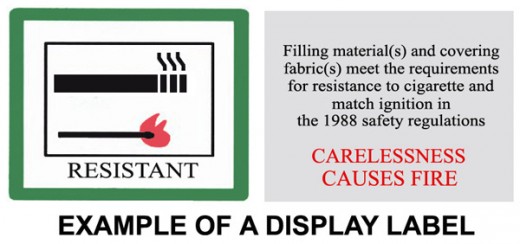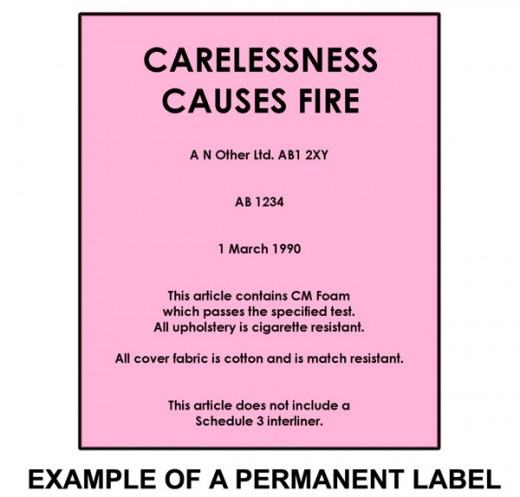Landlords and The Law of Furnishings

Recommended Reading
One of the repercussions of the buy-to-let boom is the vast number of novice landlords now struggling to survive in an alien business world. Most hire letting agents to deal with tenant management and legal compliance, but some go it alone – commonly treading where others fear to go.
Some of the legal obstacles involved in letting property are not that difficult to overcome, once you understand what is expected and how you should go about meeting the appropriate regulations. Amongst these is the requirement to supply compliant furnishings in either a part or fully furnished property. The landlord or letting agent will need to inspect the dwelling carefully and thoroughly (before it is let) to ensure furnishings and fittings meet the minimum standards. Any landlord that proceeds to let a dwelling containing non-compliant items is likely to suffer very serious and costly consequences, so this is not something that should be rushed or overlooked.
The first task all landlords should undertake is to create a worthy inventory of everything in the property. A professional inventory clerk can do this or the landlord or agent can do it. Providing the task is undertaken in a professional and comprehensive manner, it really doesn’t make much difference; though many landlords fail to take the time or attention to detail necessary and regret it later, when they need to rely on this document for damage claims against the tenant.
The inventory will record every item of furnishing and fitting supplied by the landlord as part of the rented dwelling. It will also detail the condition of each item and whether it carries the necessary manufacturer labels (more on this later). A copy of this document can now be used as a checklist to inspect the property (and all it contains) for compliance with the regulations.
There are two main volumes of law that affect furnishings supplied by landlords in the private rented sector in the United Kingdom:
- Consumer Protection Act 1987
- Furniture and Furnishings (Fire) (Safety) Regulations 1988 (as amended in 1989 and 1993)
The Consumer Protection Act demands that any items supplied together with a let property must be safe for a tenant to use. It’s that simple. So, if a hand basin in the bathroom has a crack in it, it will fail the ‘safe for use’ test – because it is likely to harbour germs (another aspect of health and safety) and it could deteriorate into a more severe form of damage. In the same way, if there is a nail protruding out of the leg of a timber coffee table, it could injure a tenant or their guests and therefore this too would fail the ‘safe to use’ test.
This is where the drawn-up inventory pays dividends because you can inspect every item on the list, identify any damage and then decide whether a repair or replacement is appropriate. Having completed this part of the task, you can confidently mark each item on the inventory as compliant with the Consumer Protection Act.
The onerous liabilities incurred by the Furniture and Furnishings (Fire) (Safety) Regulations are rather more complex, but easily checked, once you have access to the appropriate reference. This bulk of law is intended to prevent serious injury or death from fire and, more specifically, from the poisonous gases that can be released from flammable non-compliant foam-filled upholstered furnishings.
Compliance does not merely involve having legally acceptable items – but from a landlord’s point of view, they must be able to prove that the furnishings in their let property comply with the regulations. Failing to do so, particularly in the event of a fire occurring, can result in a penalty of £5,000 per item and/or a six-month prison sentence. In the event of a death occurring through a breach of the regulations, the landlord can also be charged with manslaughter and face serious civil prosecution.
The inventory can now be used to identify those items that must be inspected for compliance with the above legislation. The first task is to cross-reference the list contained within the regulations against those on the inventory. The Furniture and Furnishings (Fire) (Safety) Regulations apply to all upholstered furnishings and any that comprise any foam-filled element. They specifically include:
· Beds and mattresses, including any fixed or freestanding headboards of beds
· Sofa beds, futons and other convertible seating or bed
· Nursery furniture
· Garden furniture, which could be used or stored inside the dwelling
· Scatter cushions and seat pads, such as might be included on dining chairs
· Pillows
· Loose and stretch covers for furniture
· Additional or any replacement furniture purchased for the rented property
The regulations don’t apply to:
· Antique furniture (defined as any furniture made before 1950)
· Bed-clothes (including duvets)
· Loose covers for mattresses
· Pillowcases
· Curtains
· Carpets
· Sleeping bags.
You can now compare this list to your let property and inventory and identify the items you have provided that will need further inspection. Before that, there are a couple of matters worth clarifying.
It might seem rather odd that garden furniture appears on the list, but because garden chairs and other furnishings are sometimes stored inside the accommodation, they could (potentially) cause a fatality in the event of a fire breaking out. In addition, some tenants may employ the garden furniture as supplementary day-to-day seating, which means it could be used indoors more often than it was perhaps designed for.
Antique furniture is classed as exempt. But various intervening court cases have proved this apparently straightforward statement is not necessarily as simple as it might first seem. The problem for landlords that have so-called ‘antique’ furniture supplied within their let property is that they need to be in a position where they can prove the age of the item or items supplied. In most cases, this will need to be a statement of the age given by someone recognised by the courts (should a case ever be heard in court), such as an antique valuer.
A receipt issued by the supplier may be enough, providing it is from a reputable source and includes the age of the item of furnishing.
Landlords have occasionally attempted to pass-off old furnishings as antiques, when in reality they are merely second-hand items of little historic interest or value. These are treated in the same way as genuine items and if the evidence of age and compliance is not available, they must not be supplied in the let property. Other landlords have argued that their item of furnishing is unique and bespoke. The view of the fire authority is the only possible way of checking these items for compliance (in the absence of any other acceptable documentary evidence), is to set fire to them and see whether they ignite or produce fumes.
Clearly, there is no escaping the regulations in regard to ‘bespoke’ or ‘unique’ furniture, because if evidence of compliance does not exist, the item would need to be destroyed to test it.
Armed with your list of identified furnishings to inspect, you now need information about manufacturer labelling.
There are two types of label attached to compliant furnishings. These are classed as display and permanent labels. Landlords buying new furniture should always check the Display label is attached to the furniture at the point of purchase. These are commonly attached loosely by a thread or cord and show the cigarette resistant symbol (see image below for an example).

The permanent label is important, because it must be attached to the fabric of the furniture – and stay attached throughout the period of tenancy – for the item to be compliant. This label will include a statement from the manufacturer that the item complies with the Fire Safety Regulations (see image below for an example).

A wise landlord will take photographic evidence of the labels existing on the relevant items of furniture – and keep these safely stored, should they ever be required by the authorities at some point in the future. In addition, all purchase receipts should be retained as well as the details of both the manufacturer and the supplier. Landlords should be extremely cautious about buying furniture second-hand or from an imported source or from discount warehouses, where the quality and reputation of the manufacturer might be suspect. If an item of furnishing requiring compliance does not have the required label attached to it, it should be removed from the property prior to letting it.
Landlords should also be wary of attempting to make non-compliant furnishings compliant with the regulations by using so-called fire-protection treatments or sprays. The authorities have long-since clarified that these types of treatments are largely ineffective and therefore should not be considered.
While this legislation is pertinent to the UK, other countries have similar sets of regulations governing fire-safety in rented properties. Check with your local council, fire authority and realtor to find out what inspections you need to conduct to verify compliance, before you start looking for suitable tenants.
Useful Additional Info
- Landlord Headaches and How to Solve Them PART ONE
Landlords and buy-to-let investors operating in the UK can save themselves time and money, and prevent problems developing into major headaches, by following a few simple tips ...
- Reasons for Undertaking Property Inspections
Regular rented property inspections are a task every landlord or agent should attempt to perform, because they are the only way a landlord can be certain their investment is being cared for appropriately by...







